Rocks and Soils Notes 8th Social Science
Rocks and Soils Notes 8th Social Science
8th Social Science Lesson 5 Notes in English
5. Rocks and Soils
Introduction
- We have studied about four realms of the earth, namely lithosphere, hydrosphere, atmosphere and biosphere.
- Lithosphere is the upper most and significant layer of the earth.
- It is composed of solid rocks and unconsolidated materials.
- The literal meaning of lithosphere is “The sphere of rock”.
Rocks
- The rocks are the solid mineral materials forming a part of the surface of the earth and other similar planets.
- The earth’s crust (Lithosphere) is composed of rocks. A rock is an aggregate of one or more minerals.
- Rock is an important natural resource and is found in solid state. It may be hard or soft in nature.
- An estimation reveals that there are 2,000 different types of minerals found on the earth surface out of which only 12 are the basic minerals commonly found all over the earth.
- Minerals are chemical substances which exist in nature. Th ey may occur either in the form of elements or compounds.
8th Social Book Back Questions
Classification of Rocks
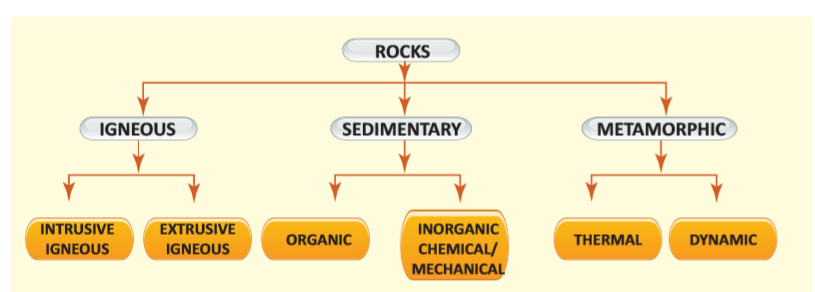
According to the mode of formation the rocks are classified into three types as follows.
- Igneous Rocks
- Sedimentary Rocks and
- Metamorphic Rocks
Igneous Rocks
- The igneous rocks are formed by the solidification of molten magma.
- These rocks are also called as the ‘Primary Rocks’ or ‘Parent Rocks’ as all other rocks are formed from these rocks.
Characteristics of Igneous Rocks
- These rocks are hard in nature
- These are impermeable.
- They do not contain fossils
- They are associated with the volcanic activities
- These rocks are useful for construction works
Types of Igneous Rocks
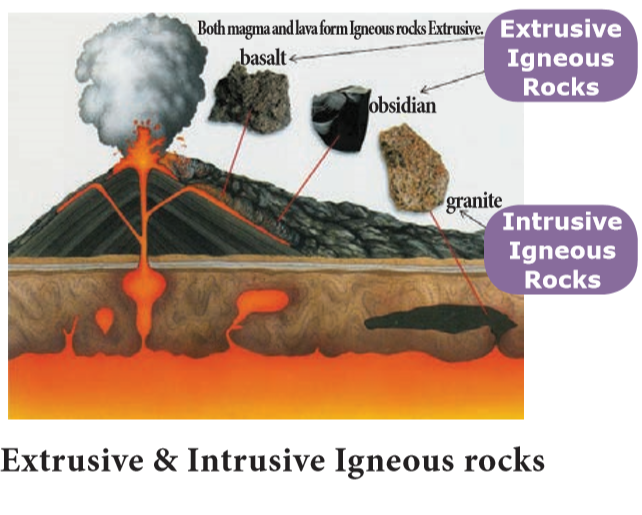
Igneous Rocks are of two types. They are:
- Extrusive Igneous Rocks
- Intrusive Igneous Rocks
Extrusive Igneous Rocks
- Lava is actually a fiery red molten magma comes out from the interior of the earth on its surface.
- After reaching the earth surface the molten materials get solidified and form rocks.
- Rocks formed in such a way on the crust are called Extrusive igneous rocks.
- These rocks are fine grained and glassy in nature due to rapid solidification.
- Basalt found in the north western part of peninsular India is the example for this type of rock.
Intrusive Igneous rocks
- The molten magma sometimes cools down deep inside the earth’s crust and becomes solid.
- The rocks formed this way is called ‘Intrusive Igneous Rocks’.
- Since they cool down slowly, they form large grains. Intrusive Igneous rocks are of two types.
- The deep seated rocks are called ‘Plutonic rocks’ and the ones formed at shallow depths are called ‘Hypabysal rocks’.
- Granite, Diorite and Gabbro are the examples of plutonic rocks and Dolerite is an example of hypabysal rocks.
- Since the intrusive Igneous rocks consist of large crystals, they are also called as ‘Crystalline rocks’.
Sedimentary Rocks
- The word ‘Sedimentary’ has been derived from Latin word ‘Sedimentum’ means settling down.
- The sedimentary rocks are formed by the sediments derived and deposited by various agents.
- Due to high temperature and pressure, the undisturbed sediments of long period cemented to form sedimentary rocks.
- Sedimentary rocks consist of many layers which were formed by the sediments deposited at different periods.
- As it consists of many strata, it is also known as ‘Stratified rocks’.
Characteristics of Sedimentary rocks
- They have many layers.
- They are non-crystalline rocks.
- They contain fossils.
- They are soft and get eroded easily
Types of Sedimentary Rocks
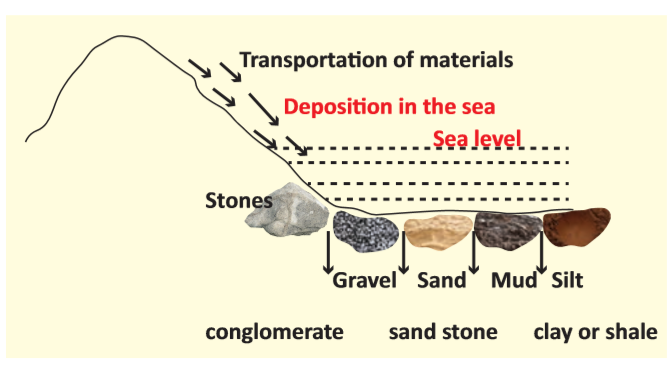
Organic Sedimentary Rocks
- These rocks are formed as a result of the decomposition of dead plants and animals. It contains fossils.
- Chalk, Talc, Dolomite and Limestone rocks are of this category.
Mechanical Sedimentary Rocks
- These rocks are formed from the disintegration of igneous and metamorphic rocks.
- The natural agents erode and transport these rocks and deposit them at some places.
- After a long period of time, they cemented to form rocks. Sandstone, Shale and Clay are the examples of rocks of this type.
Chemical Sedimentary rocks
- These are formed by precipitating of minerals from water. It is formed usually through evaporation of chemical rich solutions.
- These rocks are also called as evaporates. Rock Salt is an example of this kind.
Metamorphic Rocks
- The word Metamorphic is derived from two Greek words “Meta” and “Morpha”, Meta means change and Morpha means shape.
- When Igneous and sedimentary rocks subject to high temperature and pressure, the original rocks get altered to form a new kind of rock called metamorphic rocks.
- Metamorphism is of two types. They are Thermal Metamorphism: If the change in the rocks is mainly caused by high temperature, the process is called as thermal metamorphism.
- Dynamic Metamorphism: If the change in the rock is mainly caused by high pressure, the process is called as Dynamic Metamorphism.
Formation of Metamorphic Rocks from Igneous rocks
- Granite into gneiss caused by dynamic metamorphism.
- Basalt into slate caused by thermal metamorphism.
Formation of Metamorphic Rocks from Sedimentary rocks
- Sandstone into quartz caused by thermal metamorphism.
- Shale into slate caused by thermal metamorphism.
Characteristics of Metamorphic Rocks
- Metamorphic rocks are mostly crystalline in nature.
- They consist of alternate bands of light and dark minerals.
Rock cycle
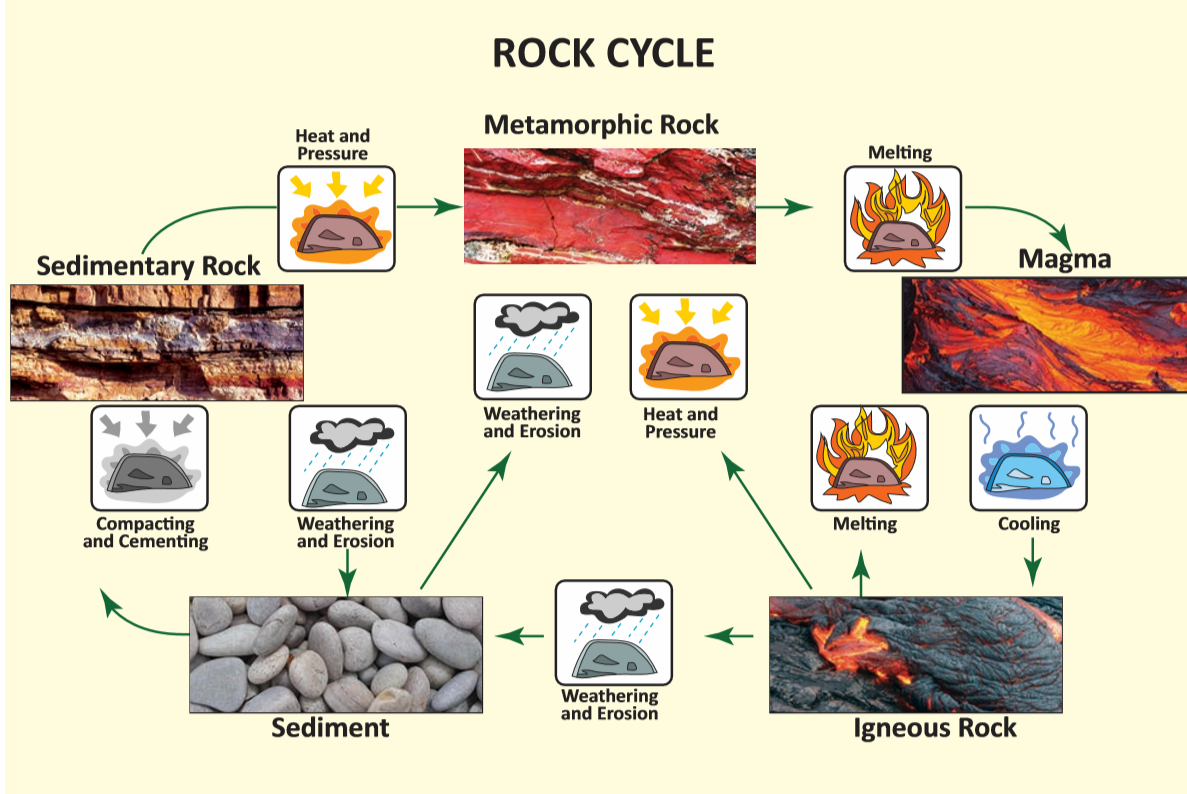
- Igneous rocks are the primary rocks formed first on the earth. These rocks are weathered, eroded, transported and deposited at some places to form sedimentary rocks.
- The Igneous and Sedimentary rocks are changed into metamorphic rocks under the influence of temperature and pressure.
- The metamorphic rocks are also get disintegrated and deposited to form sedimentary rocks.
- Formation of igneous rocks take place when there is an outflow of molten materials.
- Like this, the rocks of the earth crust keeps on changing from one form to another form under various natural forces and agents. The endless process is referred as Rock Cycle.
Uses of rocks
- Rocks have been used by mankind throughout the history. Rocks are highly valuable and important to almost all aspects of our economy.
- The minerals and metals in rocks have been found essential to human civilization.
- Rocks are used for many purposes in our life and some of them are given below
Rocks are useful for making
- Cement
- Writing chalk
- Fire
- Building materials
- Bath scrub
- Kerb stone
- Ornament
- Roofing materials
- Decorative materials
- These are valuable source of minerals such as gold, diamond, sapphire etc.
Soil and its Formation
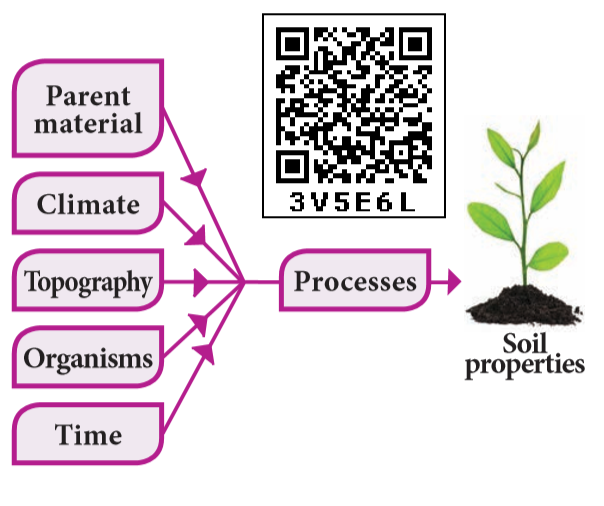
- Soil is a mixture of organic matter, minerals, gases, liquids and organisms that together support life.
- Soil minerals form the basis of soil. It forms on the surface of the earth. It is known as the ‘skin of the earth’.
- Soils are produced from rocks (parent material) through the processes of weathering and natural erosion.
- Water, wind, temperature change, gravity, chemical interaction, living organisms and pressure differences all help break down parent material.
- It leads to the formation of loose material. In course of time, they further break down into fine particles.
- This process release the minerals locked in the rock fragments.
- Later on, the vegetative cover which develop in that region forms humus content in the soil. This way the soil gets matured gradually.
Soil Composition
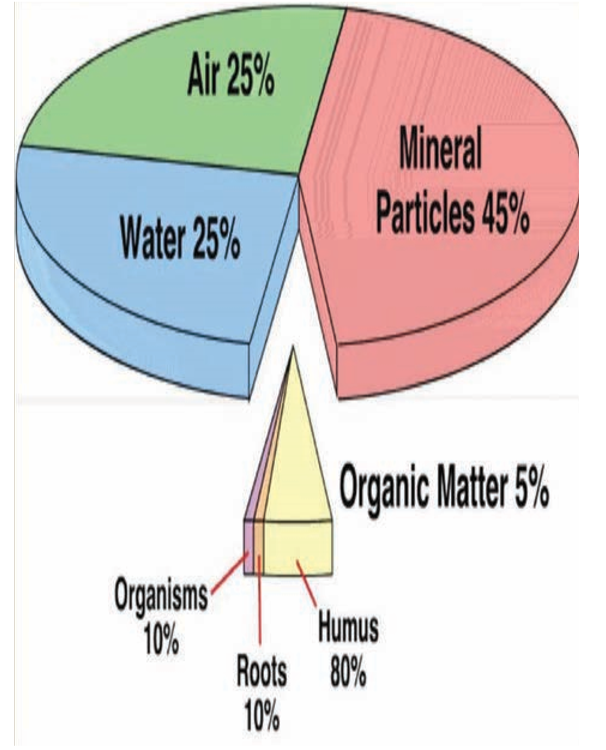
- The basic components of soil are mineral, organic matter, water and air.
- It consists of about 45% mineral, 5% organic matter, 25% of water and 25% air.
- It is only a generalized fact. The composition of soil varies from place to place and time to time.
Soil profile
The soil profile is defined as the vertical section of the soil from the ground surface and extends downwards.
Classification of soils

- Soils are classified on the basis of their formation, colour, physical and chemical properties.
- Based on these, soil is classified into six major types.
- They are: Alluvial soil, Black soil, Red soil, Laterite soil, Mountain soil, Desert soil
Alluvial soil
- These soils are found in the regions of river valleys, flood plains and coastal regions.
- These are formed by the the deposition of silt by the running water.
- It is the most productive of all soils. It is suitable for the culitivation of sugarcane, jute, rice, wheat and other food crops.
Black soils
- These soils are formed by whethering of igneous rocks.
- Black soil is clayey in nature. It is retensive of moisture. It is ideal for growing cotton.
Red Soils
- These soils are formed by wheathering of metamorphic rocks and crystalline rocks.
- The presence of iron oxide makes this soil brown to red in colour.
- It is usually found in semi-arid regions. It is not a fertile soil. It is suitable for millet cultivation.
Laterites soils
- These are the typical soils of trophical regions.
- These soils are found in the regions which experienced alternate wet and dry condition.
- As these soils are formed by the process of leaching, it is in fertile. It is suitable for plantation crops of tea and coffee.
Mountain soils
- These soils are found over the slopes of mountain. Soils in these regions are thin and acidic.
- However characteristic of soil differs from region to region based on the altitude.
Desert soils
- These are sandy soil found in the hot desert regions.
- These soils are porous and saline. Since it is infertile agriculture in these soils are not so successful.
Soil Erosion
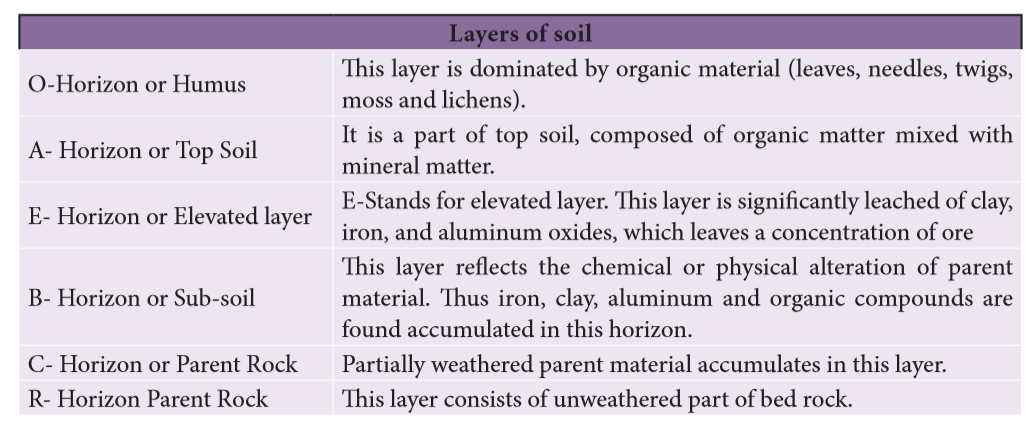
- Soil erosion is the removal or destruction of the top layer of soil by natural forces and human activities.
- Soil erosion reduces the fertility of soil which in turn reduces the agricultural productivity.
- Running water and wind are the major agents of soil erosion. Sheet erosion, Rill erosion and Gully erosion are the major types of soil erosion.
Soil conservation
- Soil conservation is the process of protecting the soil from erosion to maintain its fertility.
- The methods that are widely practiced for conserving soil are afforestation, controlled grazing, construction of dams, Crop rotation, Strip farming, contour ploughing, terrace farming, checking shifting cultivation, wind break etc.,
Uses of soils
- Soil is one of the important natural resource. It is a basic requirement for plant growth and supports various life forms on the earth.
- The minerals present in the soil enhance and nourishes the crops and plants.
- It is used in making of ceramics or pottery.
- It is a source of material for construction and handicraft works.
- It acts as natural filter of water and purifies it.
- Soil supports ecosystem and play an important role in land management. Rocks and soils are the important renewable natural resources.
- Both of them play an important role in everyday life of human beings as well as economic development.
- Nowadays rock-based companies are in increase which provide employment to a sizeable population.
- Soils attract human settlement and other economic activities.
- As India is an agricultural country, the proper management of soil resource will lead to sustainable food production besides its use for various other purposes.
- So, the soil resources must be conserved.
More to Know:
1. How long does it take to form soil?
- The time needed to form a soil depends on the Climate.
- The environments which is characterized by mild climate, takes 200400 years to form one cm of soil and in wet tropical area, soil formation is faster and takes upto 200 years.
- To become a well matured soil, it takes about 3000 years.
2. World Soil Day is observed on 5th December, every year.
3. Quartzite and Marble are the rocks commonly used for construction and sculpture works. Marbles are widely used for making beautiful statues and decorative items such as vase, tiny gift articles and grinded marble is used to produce plastics, paper etc.,
4. One of the world wonders Taj Mahal in India was built by White Marble in a metamorphic rock.
5. Sedimentary rocks are the important source of natural resources like coal, oil and natural gas.
6. Oldest sedimentary rocks of the world has been identified in Greenland and estimated as 3.9 billion years old.
7. Some major Active Volcanoes: Mount Vesuvius, Mt. Stromboli and Mt. Etna in Italy and Mauna Loa and Mauna Kea in Hawaii Islands.
8. The word Igneous is derived from the Latin word ‘Ignis’ means ‘fire’
9. Petrology is a branch of geology which deals with the study of rocks. ‘Petrology’ is derived from the Greek word “Petrus” refers to rock and “Logos” refers to study.